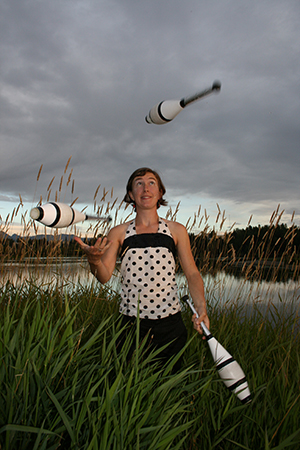|
|
|||
 |
About the Magazine | Advertising | Archives | Contact | ||
     |
|||
Send in the clown
An Alaska native brings the circus home.
Fresh from earning her Chicago degree, Meghan Holtan, AB’04, began her professional circus career in summer 2004. Graduating a year early, she joined up with fellow circus artists, including Shawn Lavoie, AB’04, and Forest Gregg, AB’04, and headed to Gregg’s Tennessee hometown in a school bus powered by vegetable oil. For the next 12 months, the five-member troupe—known as the Runaway Circus and the Loose Cabooses—performed and taught juggling, unicycling, and clowning throughout tiny dirt-road communities in Tennessee and North Carolina. “My dominant image,” says Holtan, “is of standing in parking lots in the rural South, along these highways and strip malls, filtering vegetable oil in the 100-degree weather.” They often ate and slept on the bus, which she retrofitted with two sets of bunk beds and a kitchen.

Clownin’ around: “If you don’t have people to juggle with,” says Holtan, teach them.
Today Holtan leads a more solitary existence. “It’s pretty much just me,” she says of the circus scene in her hometown of Anchorage, Alaska. Homesick for mountains and woods, she returned north when the Runaway troupe disbanded in August 2005. Holtan believed she was giving up the circus. Yet after working as a tax preparer, school-bus driver, and yurt-builder, her desire to perform and teach led her to found Anchortown Circus. Devoted to “performance, practice, and play,” the one-woman enterprise offers circus-arts workshops for students of all ages. “If you don’t have people to juggle with,” says Holtan, “you have to teach them to juggle.” Since starting Anchortown, she has trained some 550 budding performers.
Holtan’s own foray into the circus began at age 13, when she attended a fine-arts camp in Fairbanks and watched another camper unicycling down a set of outdoor steps. A teen who “didn’t quite fit in with what was going on in high school,” Holtan was smitten with the one-wheeled contraption. “This is going to be part of my life,” she decided, and struck up a friendship with the cyclist, Coire Langham. Before long she was cycling and juggling at community events with him and his parents in a troupe called Green Light Circus. By the time she joined the U of C’s student circus Le Vorris & Vox , now in its eighth year, she’d added stilts, acrobatic hand balancing, and clowning to her repertoire.
All are skills Holtan insists anyone can learn—with tangible benefits. Aside from the physical exercise, doing circus arts, she says, can help build self-esteem. An exercise in one of her clowning classes, for example, has the would-be Bozos pick an emotion. As they take turns putting on a red clown nose, the students switch emotions. “It gets you used to the idea that clown noses can transform you,” says Holtan, who travels around Alaska teaching two-week sessions for the state’s Artist in Schools residency program. “People who don’t do so well in social aspects in their school can be a different person in circus class.”
Some students, she admits, are less than enthusiastic about finding their inner clown. “People are nervous about the circus,” she says: in April, for instance, she worked with 24 high schoolers in Seldovia, a coastal town of 300. She recalls her pupils’ reluctance on the first day. “It’s kind of goofy, and when you’re a high schooler and you’re trying not to stick out, circus arts aren’t necessarily what you want to be doing.” By the second day, however, students were showing up at school early to practice juggling and unicycle riding.
Back in Anchorage, Holtan remains the go-to source for all things circus. In May she played a unicycling superhero, donning a cape and balancing trash on her face for a local beach clean-up day. This summer she’s doing shows for the Anchorage Municipal Libraries about a clown who has to stay home from the circus when he catches the “reading bug.” Up next on her agenda: The Music Box, a 45-minute solo circus-theater piece about a music box that loses its melody.
Despite its many performance opportunities, Anchorage can be a challenging venue. Take fire juggling. With 18-plus hours of daylight in the summer, says Holtan, “when it’s warm enough to juggle outside, it’s not dark enough. And in the winter time, it’s freezing cold.” That hasn’t stopped her from juggling flames for the downtown Anchorage New Year’s Eve bash three years in a row. “You wear gloves, keep moving, and make jokes about warming your hands over the fire.” Besides, she adds, pretty much any Alaskan climate beats filtering vegetable oil in the triple-digit heat of the American South.